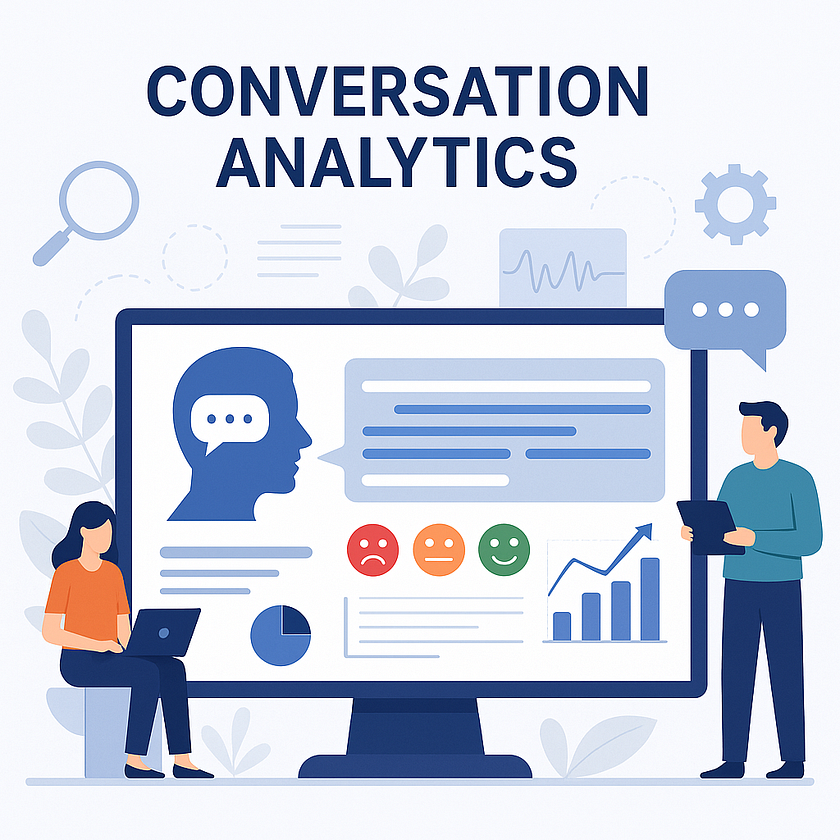Unlocking the Power of Conversation Analytics: Transforming Talk into Actionable Insights

In the digital age, where customer interactions span across multiple platforms — calls, chats, emails, and social media — understanding what customers say and how they say it has become a vital source of business intelligence. This is where conversation analytics steps in, turning raw communication data into actionable insights that drive business growth, improve customer experience, and streamline operations.
What is Conversation Analytics?
Conversation analytics refers to the process of collecting, transcribing, and analyzing verbal and written communications between customers and businesses. These can include phone calls, live chats, emails, and even social media messages. Using technologies like Natural Language Processing (NLP), Machine Learning (ML), and Speech Recognition, conversation analytics software can identify patterns, sentiments, intents, and even compliance issues within interactions.
Unlike traditional analytics that focus on numbers and metrics, conversation analytics dives deep into the actual content of conversations. It helps organizations understand what their customers truly want, how agents respond, and where the communication could be improved.
Why Conversation Analytics Matters
Customer expectations have never been higher. A single poor interaction can lead to churn, while a great conversation can turn a casual visitor into a loyal customer. Conversation analytics enables businesses to:
- Uncover customer intent: Understanding the true purpose behind a customer’s message helps in offering the right solution quickly.
- Improve agent performance: By analyzing conversations, managers can provide personalized feedback and coaching to their customer service representatives.
- Enhance customer experience: Real-time insights allow businesses to identify friction points and address them proactively.
- Ensure compliance: Automated monitoring helps in flagging conversations that don’t adhere to regulatory requirements or company policies.
- Drive revenue growth: Identifying upselling or cross-selling opportunities through conversation analysis can directly impact sales.
Key Components of Conversation Analytics
- Speech-to-Text Transcription
This is the foundation. Voice calls are transcribed into text using AI-powered speech recognition tools. Accurate transcription is crucial for meaningful analysis. - Sentiment Analysis
Once transcribed, conversations are analyzed for sentiment — positive, negative, or neutral. This helps in gauging customer satisfaction in real time. - Keyword and Phrase Detection
The software scans for specific keywords, phrases, or topics. For instance, recurring mentions of “slow delivery” could highlight a logistical issue. - Intent Recognition
AI models are trained to understand the purpose behind a customer’s query. Is the customer calling to complain, inquire, or buy something? Knowing the intent drives more effective responses. - Emotion Detection
Advanced tools can detect emotions like frustration, excitement, or confusion in a customer’s voice or choice of words, adding another layer of understanding. - Trend Analysis
By aggregating data across thousands of conversations, businesses can detect trends — seasonal inquiries, product issues, or emerging customer preferences.
Use Cases Across Industries
Conversation analytics isn’t just for call centers. Its applications span multiple industries:
- Retail & E-commerce: Understand what customers are looking for, detect issues in delivery or checkout, and improve product recommendations.
- Healthcare: Analyze patient feedback to enhance service delivery and ensure compliance with medical communication standards.
- Banking & Finance: Detect fraud, ensure script compliance, and improve service offerings based on frequent queries.
- Telecommunications: Reduce churn by identifying common service complaints and improving resolution rates.
- Travel & Hospitality: Capture feedback to enhance booking experiences and personalize services.
Real-Time vs Post-Interaction Analytics
Conversation analytics can be deployed in two modes:
- Real-time analytics provides insights while the conversation is ongoing. It can guide agents with prompts, alerts, or suggested responses.
- Post-interaction analytics processes the conversation after it ends. It’s more detailed and used for quality assurance, training, and strategy development.
Both modes serve different purposes, and businesses often use a combination to maximize impact.
Benefits of Implementing Conversation Analytics
- Better Decision-Making: By understanding the “why” behind customer behavior, companies can make more informed strategic decisions.
- Increased Efficiency: Automated analysis reduces the need for manual call listening and speeds up issue detection.
- Enhanced Customer Loyalty: Personalized interactions foster stronger relationships with customers.
- Revenue Optimization: Identifying what customers value most helps businesses tailor their offerings effectively.
- Scalability: As your business grows, analyzing thousands of conversations manually becomes impossible — automation through analytics bridges that gap.
Challenges and Considerations
While the benefits are clear, implementing conversation analytics does come with challenges:
- Data Privacy: Businesses must ensure they comply with data protection laws like GDPR and CCPA.
- Accuracy: AI models must be regularly updated and trained to maintain high accuracy, especially in multilingual or heavily-accented environments.
- Integration: The analytics tool should integrate smoothly with existing CRM and contact center platforms for optimal utility.
The Future of Conversation Analytics
As AI technology continues to evolve, conversation analytics will become even more intelligent and predictive. We can expect deeper integrations with CRM systems, enhanced emotion recognition, and more contextual understanding. Conversational AI may soon not only analyze but also engage, offering automated yet human-like responses that adapt in real time.
In a world where every conversation counts, businesses that harness the power of conversation analytics will stay a step ahead — listening better, responding smarter, and growing faster.
Final Thought:
Conversation analytics is not just a tool — it’s a lens through which businesses can better understand their customers, employees, and operations. By converting talk into data, and data into action, companies can create more meaningful, efficient, and profitable customer interactions.


Comments
Post a Comment